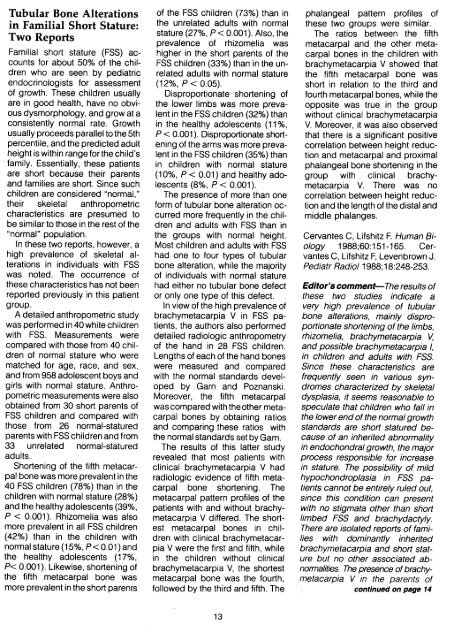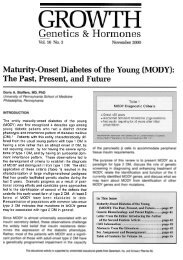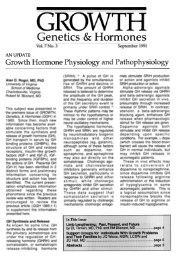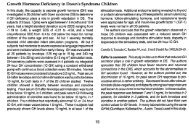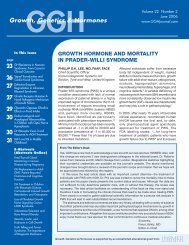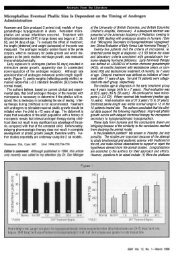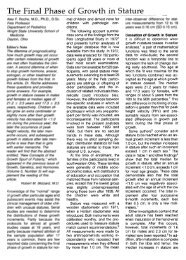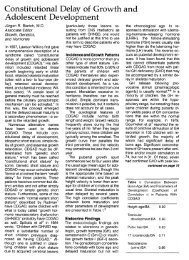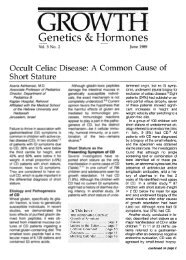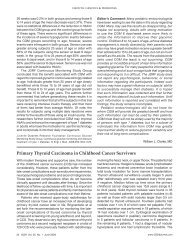Tubular Bone Alterations in Familial Short Stature - GGH Journal
Tubular Bone Alterations in Familial Short Stature - GGH Journal
Tubular Bone Alterations in Familial Short Stature - GGH Journal
Create successful ePaper yourself
Turn your PDF publications into a flip-book with our unique Google optimized e-Paper software.
<strong>Tubular</strong> <strong>Bone</strong> <strong>Alterations</strong> of the FSS children (73%) than <strong>in</strong> phalangeal pattern profiles of<br />
<strong>in</strong> <strong>Familial</strong> <strong>Short</strong> <strong>Stature</strong>: the unrelated adults with normal these two. groups were simila~.<br />
stature (27%, P < 0.001 ). Also, the The ratIos between the fifth<br />
Two Reports prevalence of rhizomelia was metacarpal and the other meta-<br />
<strong>Familial</strong> short stature (FSS) ac- higher <strong>in</strong> the short parents of the carpal bones <strong>in</strong> the children with<br />
counts for about 50% of the chil- FSS children (33%) than <strong>in</strong> the un- brachymetacarpia V showed that<br />
dren who are seen by pediatric related adults with normal stature the fifth metacarpal bone was<br />
endocr<strong>in</strong>ologists for assessment (12%, P < 0.05). short <strong>in</strong> relation to the third and<br />
of growth. These children usually Disproportionate shorten<strong>in</strong>g of fourth metacarpal bones, while the<br />
are <strong>in</strong> good health, have no obvi- the lower limbs was more preva- opposite was true <strong>in</strong> the group<br />
ous dysmorphology, and grow at a lent <strong>in</strong> the FSS children (32%) than without cl<strong>in</strong>ical brachymetacarpia<br />
consistently normal rate. Growth <strong>in</strong> the healthy adolescents (11%, V. Moreover, it was also observed<br />
usually proceeds parallel to the 5th P < 0.001). Disproportionate short- that there is a significant positive<br />
percentile, and the predicted adult en<strong>in</strong>g of the arms was more preva- correlation between height reducheight<br />
is with<strong>in</strong> range for the child's lent <strong>in</strong> the FSS children (35%) than tion and metacarpal and proximal<br />
family. Essentially, these patients <strong>in</strong> children with normal stature phalangeal bone shorten<strong>in</strong>g <strong>in</strong> the<br />
are short because their parents (10%, P < 0.01) and healthy ado- group with cl<strong>in</strong>ical brachyand<br />
families are short. S<strong>in</strong>ce such lescents (8%, P < 0.001). metacarpia V. There was no<br />
children are considered "normal," The presence of more than one correlation between height reductheir<br />
skeletal anthropometric form of tubular bone alteration oc- tion and the length of the distal and<br />
characteristics are presumed to curred more frequently <strong>in</strong> the chil- middle phalanges.<br />
be similar to those <strong>in</strong> the rest of the dren and adults with FSS than <strong>in</strong><br />
"normal" population. the groups with normal height. Cervantes C, Lifshitz F. Human Bi-<br />
In these two reports, however, a Most children and adults with FSS ology 1988;60:151-165. Cerhigh<br />
prevalence of skeletal al- had one to four types of tubular vantes C, Lifshitz F, Levenbrown J.<br />
terations <strong>in</strong> <strong>in</strong>dividuals with FSS bone alteration, while the majority Pediatr RadiQ/1988;18:248-253.<br />
was noted. The occurrence of of <strong>in</strong>dividuals with normal stature<br />
these characteristics has not been had either no tubular bone defect Editor's comment- The results of<br />
reported previously <strong>in</strong> this patient or only one type of this defect. these two studies <strong>in</strong>dicate a<br />
group. In view of the high prevalence of very high prevalence of tubular<br />
A detailed anthropometric study brachymetacarpia V <strong>in</strong> FSS pa- bone alterations, ma<strong>in</strong>ly disprowas<br />
performed <strong>in</strong> 40 white children tients, the authors also performed portionate shorten<strong>in</strong>g of the limbs,<br />
with FSS. Measurements were detailed radiologic anthropometry rhizomelia, brachymetacarpia lI:<br />
compared with those from 40 chil- of the hand <strong>in</strong> 28 FSS children. and possible brachymetacarpia I,<br />
dren of normal stature who were Lengths of each of the hand bones <strong>in</strong> children and adults with FSS.<br />
matched for age, race, and sex, were measured and compared S<strong>in</strong>ce these characteristics are<br />
and from 958 adolescent boys and with the normal standards devel- frequently seen <strong>in</strong> various syngirls<br />
with normal stature. Anthro- oped by Garn and Poznanski. dromes characterized by skeletal<br />
pometric measurements were also Moreover, the fifth metacarpal dysplasia, it seems reasonable to<br />
obta<strong>in</strong>ed from 30 short parents of was compared with the other meta- speculate that children who fall <strong>in</strong><br />
FSS children and compared with carpal bones by obta<strong>in</strong><strong>in</strong>g ratios the lower end of the normal growth<br />
those from 26 normal-statured and compar<strong>in</strong>g these ratios with standards are short statured beparents<br />
with FSS children and from the normal standards set by Garn. cause of an <strong>in</strong>herited abnormality<br />
33 unrelated normal-statu red The results of this latter study <strong>in</strong> endochondral growth, the major<br />
adults. revealed that most patients with process responsible for <strong>in</strong>crease<br />
<strong>Short</strong>en<strong>in</strong>g of the fifth metacar- cl<strong>in</strong>ical brachymetacarpia V had <strong>in</strong> stature. The possibility of mild<br />
pal bone was more prevalent <strong>in</strong> the radiologic evidence of fifth meta- hypochondroplasia <strong>in</strong> FSS pa-<br />
40 FSS children (78%) than <strong>in</strong> the carpal bone shorten<strong>in</strong>g. The tients cannot be entirely ruled out,<br />
children with normal stature (28%) metacarpal pattern profiles of the s<strong>in</strong>ce this condition can present<br />
and the healthy adolescents (39%, patients with and without brachy- with no stigmata other than short<br />
P < 0.001). Rhizomelia was also metacarpia V differed. The short- limbed FSS and brachydactyly.<br />
more prevalent <strong>in</strong> all FSS children est metacarpal bones <strong>in</strong> chil- There are isolated reports of fami-<br />
(42%) than <strong>in</strong> the children with dren with cl<strong>in</strong>ical brachymetacar- lies with dom<strong>in</strong>antly <strong>in</strong>herited<br />
normal stature (15%, P< 0.01) and pia V were the first and fifth, while brachymetacarpia and short statthe<br />
healthy adolescents (17%, <strong>in</strong> the children without cl<strong>in</strong>ical ure but no other associated ab-<br />
P< 0.001). Likewise, shorten<strong>in</strong>g of brachymetacarpia V, the shortest normalities. The presence of brachythe<br />
fifth metacarpal bone was metacarpal bone was the fourth, metacarpia V <strong>in</strong> the parents of<br />
more prevalent <strong>in</strong> the short parents followed by the third and fifth. The cont<strong>in</strong>ued on page 14<br />
13
cont<strong>in</strong>ued from page 13 term<strong>in</strong><strong>in</strong>g stature by express<strong>in</strong>g it-<br />
affected FSS chi(dren suggests ~n self n~t only <strong>in</strong> over~/1 height but<br />
heritance autosomal of dom<strong>in</strong>ant this characteristic. mode of In- also en<strong>in</strong>g In of disproportionate tubular bones <strong>in</strong> short- those<br />
This trait is also fairly common with FSS.<br />
even <strong>in</strong> the normal population. The presence of tubular bone<br />
Therefore its association with FSS alterations <strong>in</strong> an otherwise healthy<br />
may be co<strong>in</strong>cidental. However, patient with FSS should be cares<strong>in</strong>ce<br />
these tubular bone al- fully evaluated before <strong>in</strong>stitut<strong>in</strong>g<br />
terations were significantly more therapy with growth hormone<br />
<strong>in</strong> the FSS children and (GH). This is especially important<br />
their parents and sibl<strong>in</strong>gs than <strong>in</strong> s<strong>in</strong>ce GH is now available <strong>in</strong> unlimthe<br />
normal population, an <strong>in</strong>herited ited supply and pressure to treat<br />
trait is most likely responsible for the short child with the drug is<br />
pleiomorphic manifesta- aga<strong>in</strong> high. It may be reasonable<br />
tions. Segregation analysis may to expect that children with FSS<br />
help determ<strong>in</strong>e the mode of <strong>in</strong>- who also have skeletal abnormalof<br />
these skeletal ities would respond less favorably<br />
alterations. to GH or require a higher dose of<br />
The f<strong>in</strong>d<strong>in</strong>gs <strong>in</strong> these two studies GH than would those with FSS and<br />
the major role that endo- no bone abnormalities.<br />
ossification plays <strong>in</strong> de- Fima Lifshitz, M.D.


